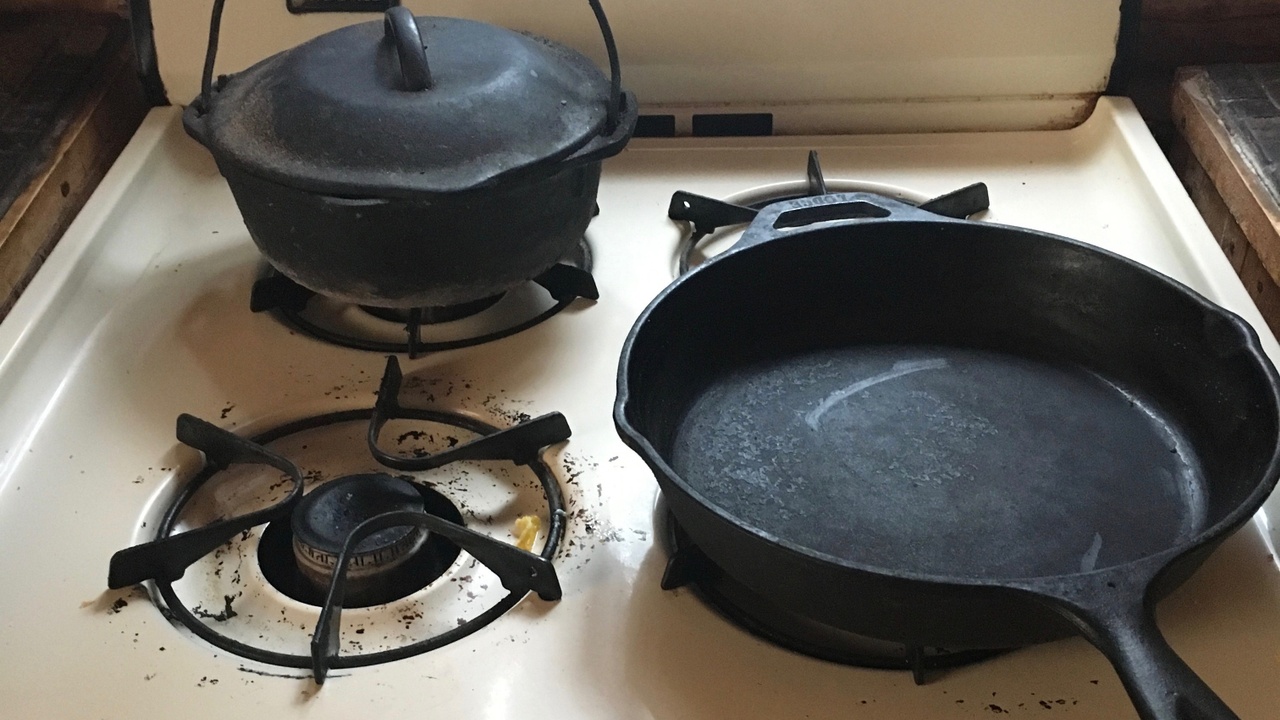Care and Use of Cast Iron Cookware

In one of my previous blog posts, Off Grid Cookware: What Are Your Options, I discussed somewhat at length the versatility and value in using cast iron cookware. This type of cookware is in fact one of my favorites for that very reason. When I think of cooking a meal, I reach for the cast iron cookware first.
My initial reason for switching to cast iron had nothing to do with the homestead. At the time, I cooked primarily with teflon. But, after reading a report about the toxicity of teflon when over heated, I immediately ditched the teflon and switched almost exclusively to cast iron.
Fast forward a few years to my homestead life, cast iron is my primary cookware due to its versatility and durability. I use it on the kitchen stove, in the oven, on top of the wood stove and in the wood stove. Over the years, I’ve experimented and learned many tricks for utilizing this valuable cookware.
History and Production of Cast Iron

Cast iron cookware has been around since the Han Dynasty in China, circa 220 A.D. Casting techniques were widespread in Europe in the 16th century. In 1707, Abraham Darby developed the sand casting technique, which is similar to what is used today.
Modern cast iron cookware is made from a mixture of iron, steel, and various alloys. This mixture is melted in a furnace that runs at over 2000 degrees F. The molten iron mixture is poured into a sand casting mold which holds its shape since sand melts at a higher temperature than the iron. Once the iron has cooled, the sand mold is broken and the new cast iron pot or pan is removed. This process of sand molding has been around since 680 B.C.
Lodge Cast Iron is one of the most popular brands in the United States. Visit the Lodge Cast Iron Foundry here.
Why is Cast Iron Cookware So Popular?
1) Concerns over toxicity
It is now known that certain types of coated non-stick cookware emits toxic fumes when over heated. Consequently, many people are switching to cast iron because no such concerns exists. In fact, cast iron can be heated to extremely high temperatures with no concerns.
Additionally, while cooking with cast iron, you will use less oil and your food will be fortified with a little extra iron.
2) Durability
We live in a consumer focused society where planned obsolescence keeps us spending money. Products are produced with a limited lifespan. Therefore, you have to buy another. Alternatively, well cared for cast iron will literally last for hundreds of years.
3) Cooking Advantages
Cast iron is the stove top version of a grill. A well heated cast iron skillet sears meat and other foods and locks in the flavor. It is a great alternative to cooking on a grill.
Commons Myths About Cast Iron

Cast Iron is Difficult to Maintain
While cast iron does require some on-going maintenance, it is actually an easy process. Properly maintained cookware is durable and will last for hundreds of years. This is why my grandmother had the same cookware for most of her life.
Cast iron cookware can never be washed with soap
Dish soap is designed to break down oil. Most people mistakenly assume that cast iron cookware is coated with oil. However, the fact is that when cast iron is coated with oil and subjected to high heat, the oil breaks down, is polymerized and bonds to the surface of the cookware. Then end product that produces the seasoning is not actually oil any longer.
What this means is that washing a cast iron skillet with soapy water is actually okay. However, you never want to soak the skillet in water. This will break down the seasoning and may result in rust.
An alternative to cleaning a cast iron skillet is to apply a little salt to the surface and scrub with a sponge. The salt acts an abrasive and will help to cleaned excess debris from the surface. That said, the best time for deep cleaning with soapy water is just before the re-seasoning process.
Cast iron cookware is completely non-stick
A well seasoned cast iron pan has an amazing non-stick surface. However, the pan needs to be preheated prior to cooking. If you place cold food in a cold cast iron pan, food is going to stick.
In contrast, other non-stick surfaces such as Teflon, can be used cold and will still be non-stick. But then you have to deal with all of the disadvantages to using Teflon.
Cast iron heats evenly
Cast iron is actually a poor conductor of heat. The technical term is thermal conductivity, which is a measure of a material’s ability to transfer heat from one part to another. Consequently, cast iron needs to be preheated prior to placing food in the pan. The advantage to cast iron cookware is that once it is heated, it retains heat for a long time.
Cast iron rusts easily
Bare iron is highly susceptible to rusting. This is why cast iron cookware used to be shipped after it was coated with a thin layer of wax. Modern cast iron cookware is factory seasoned. Once in your possession, if it is properly cared for it should not rust. The good thing is that if is does, you can clean it off, re-season it and you are good to go.
Never cook acidic food in cast iron

Brief exposure to acid foods is not going to affect and well seasoned skillet. However, you should avoid long simmering of acid foods such as tomatoes sauces. You should also avoid long simmering of foods with strong spices such as Indian food.
The potential problem is that the acidic food will break down the seasoning. If this does happen, you can re-season the cookware. The other potential problem is that is you use strong tasting spices, such as turmeric, the spices can penetrate into the iron and the taste will transfer to other foods. You can avoids these potential problems by using a well seasoned pan and removing the food and cleaning the pan immediately after cooking.
What Is Cast Iron “Seasoning”?
Cast iron is “seasoned” through a process called polymerization. When the cookware is coated with a layer of oil then baked at a high enough temperature, the wet oil turns into a hard, slick surface that is actually bonded to the iron on a molecular level. The oil is essentially carbonized. Without this layer the iron would quickly rust from the natural moisture in the air.
Proper care of cast iron
If properly cared for, cast iron cookware will last hundreds of years. Proper care is truly very simple. Just follow these simple rules:
Initial seasoning: If the cookware is not seasoned when you get it, do this immediately. (Follow the instructions below.) If it is pre-seasoned, wash the cookware with warm soapy water to remove the protective film from the outside surface that is typically factory applied. Then heat the skillet so it will dry. Apply and thin layer of oil and allow it to cool. Store until needed.
Clean after each use: After using the cookware, clean it while it is still slightly warm. You can use warm soapy water or sprinkle salt in the pan and use a scrub sponge. The salt simply acts as an abrasive material. Slightly reheat the pan to make sure it is completely dry. Coat with a thin layer of oil before storing.
Use it often: Cooking in cast iron helps to keep it seasoned. Searing meat, frying, and baking is especially good for maintaining the seasoning.

Keep it dry: Even if a pan is well seasoned, it needs to stay completely dry. After each use, clean as recommended above and coat with a thin layer of oil. Never soak cast iron cookware in water.
How to Re-season or Resurface Cast Iron
This is when a skillet needs to be re-seasoned.
Step One
Wash the cookware thoroughly in warm soapy water. If there is rust present, then scrub with a steel wool pad until all rust is removed.
Step Two
After washing, initially dry the cookware with a towel. Then place it on a range burner to thoroughly heat the pan. Alternatively, I place my cookware on top of my wood stove especially in the winter.
Step Three
Coat the entire surface of the cookware with a thin layer of oil. If needed, use a towel to remove any excess oil. All you need is a thin layer.

Step Four
Place the pan in the oven, cooking surface facing down. Bake for one hour at 400 to 450 degrees F. Alternatively, I have placed my cast iron up side down on top of my wood stove. However, you have to keep the wood stove pretty darn hot in order to maintain the proper temperature.

Once finished, turn the oven off and allow it to cool completely before storing.
If properly cared for, cast iron cookware can literally be the most durable, dependable, long-lasting cookware you will ever have. It is my first choice for cooking most foods and I tend to use it every single day.
Go off grid and live well,
Patrick
Stay connected with us to receive regular updates.
Join our mailing list to receive the latest news and updates from our team. We always respect your privacy. Your information will never be shared.






